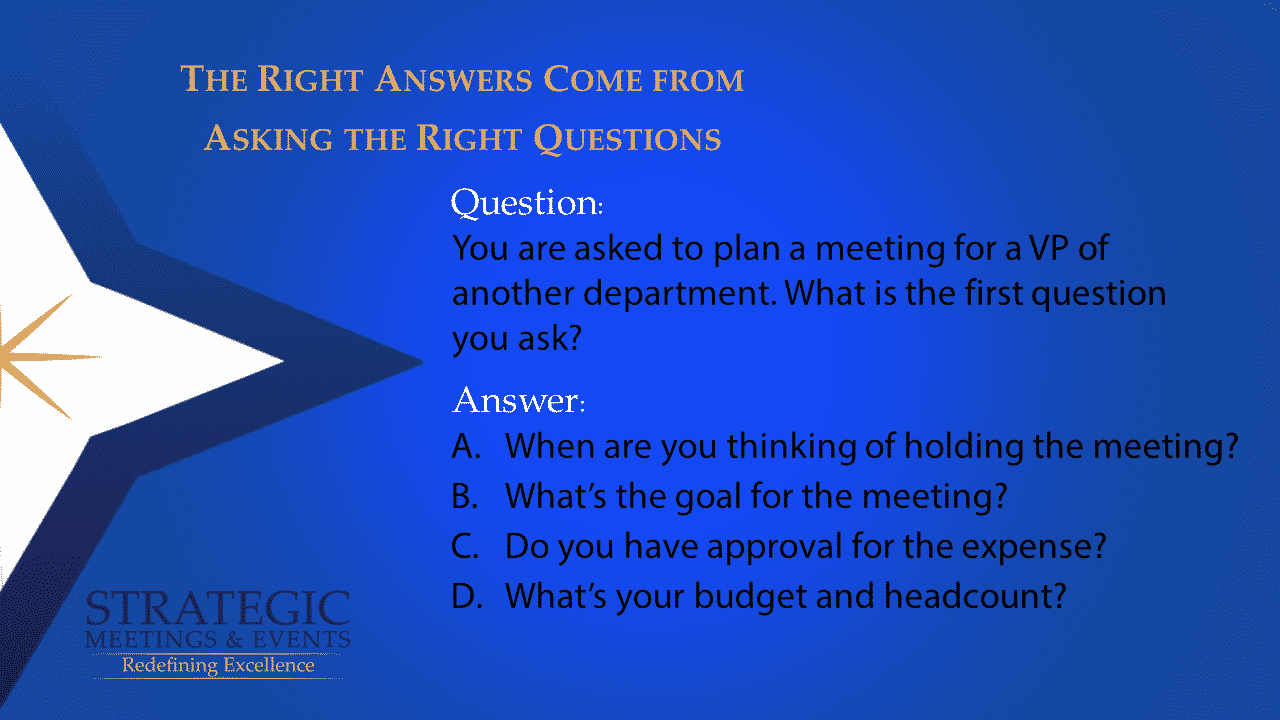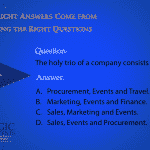You are asked to plan a meeting for a VP of another department. What is the first question you ask?


Years ago, I was planning a sales meeting for 300 people. We were six weeks out from the five-day sales conference. The finish line was in sight.
We were a San Francisco-based company and the dot-com bubble was still shiny and whole. My CEO had no defined goal for the meeting, but he was a billionaire writing the checks, and things ran as he wished. He wanted a “gold rush” theme because he liked the geographic tie-in.
All was going well until two weeks before the meeting. The CEO changed the theme to a movie he’d seen. Everything had to be scrapped and redone. We spent more in rush charges than the cost of the items. Yep, I’m serious.
After the smoke cleared, I sat with my CEO and explained the cost of his capriciousness. I wish I could tell you that the next year things were different, but I can’t. We went out of business six months later. He had no plan for that either.
This story is proof that setting and reaching goals is crucial to staying in business. Setting goals — creating excitement for a new product launch or helping the sales force deal with change, for example — should be what drives you. Your theme and message should support the goal. Continue to ask yourself how each aspect of the process reinforces the goal. Then you can plan and design the marketing, collateral, gifts and even meals to reflect your theme and goal.

Start by answering this question: What is the one thing people should remember and take action on as a result of this meeting? Focus on that one issue and build your agenda — theme, stage design, interactions, breaks and meals and entertainment.
Look for a theme that will bring your points to action. Themes give people a common point of reference. A public speaker may help reinforce your message. (Looking for a speaker? Try a speaker’s bureau or ask around for recommendations.)
Stage design is key; remember this will be a focal point for attendees for a great deal of the meeting. Consider using multi-screens, shifts in lighting and moving parts that will keep viewers engaged and stimulated.
Plan extended break times for networking and snacks that boost mental awareness. Snacks such as “make your own trail mix” or “design your own yogurt parfait” are healthy and interactive. Food presentations should support the theme and look inviting. Remember we eat with our eyes, too.
Interaction among participants also is important. This is the perfect opportunity to encourage and recognize top performers. Doing so will take the energy through the roof, which is important. And with innovations like audience response polling, making your general session interactive is easy. These systems let you collect and summarize thousands of live-voting responses instantly. Data can even be automatically displayed.
When entertaining the group at meal functions, design the room to foster networking and interaction. Lighting sets the tone. Keep florals low or above sight lines so attendees can make eye contact.
An example: At a recent outdoor event in Scottsdale, I was challenged to create the perfect setting for the final night dinner. The client chose an outdoor space, a terraced lawn. This location offered me just enough space for my needs and several layout options. I was working with a limited budget, so I chose to make the layout work as my “wow” factor. I ran one long table set for 42 guests down the length of the lawn. With no ceiling height restrictions, eight tall candelabras were used down the center of the table. Each candelabrum featured lush florals in the saturated sunset tones of the Arizona sky. Additional low florals, decorative charger plates and a multitude of pillar candles in staggered heights, completed the tablescape.
I put the band at the far end of the table on one of the terraced areas, which worked perfectly as a stage and focal point. Everyone could look down the center of the table, watch people dance and enjoy the entertainment.
My lighting design was simple and cost-effective. I washed the entire area using a soft gel tone — up-light bastard amber — to warm up the skin tones of our guests and up-lit the various foliage in the same tones as the flowers. In a well-choreographed and synchronized system, the wait staff served guests beautifully plated courses from opposite sides of the table, so that guests could begin eating as soon as they were served. The evening was hailed as a total success and all it took was seeing the big picture first and paying attention to the important details that pull it all together. So you see, with so many elements supporting your goal, it’s an easy thing to accomplish. Start at the end and you will end up on top.
Always remember, smart is beautiful!





